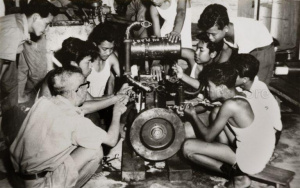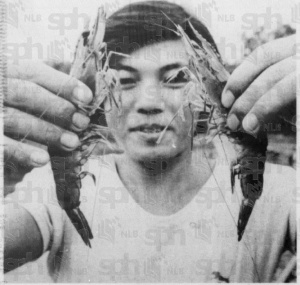Prawn farms in Singapore (1978 - 1987)
In 1961, the Ministry of National Development announced the start of a S$4.5 million reclamation project. 4,000 acres of swamp-land was reclaimed, out of which 1,000 acres were set aside for prawn ponds.[1] Completed in 1965, the project ushered in an era of modern-era farming as prawn farmers cultivated new methods to produce and improve prawn yields for local and overseas consumption.
Background
It was forecasted that the reclamation project would provide employment to around 100 fishermen and 1,000 farmers, as well as 500 other workers in related occupations. It was estimated that a total of 1,200 tonnes of fish and prawn would be produced from the new farms and ponds.[2]
In 1963, the first phase of the project which reclaimed 176 acres of swamp-land around Sungei Poyan was completed. Then Minister for National Development, Mr Tan Kia Gan, toured the area before announcing that the state would set up a co-operative to run and advice on the prawn and fish ponds in the reclaimed area.[3]
Primary Production Department (1959 - 2000)
In 1959, the Primary Production Department (PPD), the state’s advisory service for Singaporean farmers, was launched. It consisted of five divisions - Agriculture, Fisheries, Veterinary, Co-operative Development and Rural Development. The PPD was set up to help farmers increase their farm produce and provide guidance on ways to improve their catches and breeding fish.[4]
By 1965, the PPD conducted regular visits to fisheries to render technical service and offer on-the-spot advice to prawn and fish cultivators.[5] The department had an important task of overseeing Singapore’s domestic food production. On 1 April 2000, the PPD was restructured into a statutory board and renamed as the Agri-Food and Veterinary Authority of Singapore (AVA).[6]
Prawn farms (1978 - 1987)
One of the ways the PPD sought to improve the quality of domestic produce was by financing new technological methods that would increase prawn harvest.[7] Between the late 1970s and 1980s, high-yielding prawn farms were being established in Singapore alongside the growing technologies of the PPD.
Hai Tai Fish Farm (1978)
The late 1970s saw the first successful harvest of locally-hatched freshwater giant prawns (udang galah) by Hai Tai Fish Farm. With technical assistance from the PPD, the farm was the first Singaporean hatchery to venture into commercially producing prawns.[8] The hatchery ran by Mr Quek Kin Boon, started with only 10 pairs of breeding prawn stock from the PPD’s freshwater fisheries laboratory.
To cultivate the prawns, the hatchery had 20 concrete tanks filled with water that was provided with hot air. This was a requirement as a consistently high temperature was needed for the incubation and hatching of prawn eggs and breeding of fry.[9] The total cost for equipment amounted to S$10,000.[10] A projected 150,000 to 200,000 prawns could be produced monthly.[11]
The prawn larvae were usually fed with cockles, steamed egg custard and other feeds such as clams and fish eggs.[12] Their diet consisted of 75% animal materials, with the rest made up plant materials. The young prawns could grow to about 20cm long and weigh about 200g each in five to six months if properly cultivated.[13]
Aquaculture Singapore Pte Ltd (1980)
In 1980, Aquaculture Singapore was established to meet Singaporean’s increased prawn consumption. It was reported that locals approximately consumed 30,000 fresh and 42,000 frozen prawns a day and that amounted to 13 million prawns a month.[14]
Aquaculture bought pregnant tiger prawns from local farms for breeding and production. Tiger prawns were regarded as the easiest prawns to breed because they could survive in water with 20 to 100% salinity. These prawns were highly adaptable and grew faster with improved feed conversion. They were commercially feasible, costing less to upkeep and could be harvested frequently. Each mother prawn can spawn between 50,000 to one million fries. To ensure their survival, the fries were kept under constant supervision for the first 10 days of their lives. As a result, Aquaculture was able to obtain a 20% survival rate of its fries which was considered a commendable feat.[15] By 1984, Aquaculture was the only farm that had a completely integrated farming and hatchery and was considered a pioneer in “high-tech” farming.[16]
Aquaculture Singapore’s managing director, Mr Alex Chin, revealed that the company projected a turnover of S$800,000 as soon as it reached full production in 1982. He planned to turn out two million fries a month. In turn, Aquaculture would sell half of them to local farmers at 5 cents each, a price that was considerably cheaper than the current market price of 8 to 10 cents.[17]
Tiger Prawn Marine Culture Pte Ltd (1981 - 2017)
A pioneer in scientific breeding, the Tiger Prawn Marine Culture was set up to scientifically breed prawns at the farm. The father and son team from Taiwan, Mr Chai Zen Chuan and the younger Mr Chai Whun Ching studied the breeding of tiger prawns, channelling their research to meet local consumption. According to the older Mr Chai, the Singapore climate was suitable for three prawn harvests per year. Mr Leck Kim Koon, one of the owners of Tiger Prawn Marine Culture, claimed that the farm sold about 757kg of prawns every morning although there were no plans for export yet.[18]
When properly cultured, a full-grown prawn from Tiger Prawn Marine Culture measured 25cm in length. These scientifically bred prawns required careful attention, especially at the post-larval stage where mortality rates were high. The tanks’ exposure to sunlight, the chemical composition of seawater and temperature where larvae grew were closely monitored.[19]
Hitachi Zosen Singapore Shipyard (1986)
Hitachi Zosen launched an experimental prawn cultivation programme in August 1986 as part of its efforts to diversify business after a recession. The S$1.2 million side project imported 40 to 60 Kuruma “mother prawns” each week from Japan which were then kept in eight hatchery ponds. Each mother prawn would lay between 50,000 and 100,000 eggs. After hatching, the fries were then transferred to 24 bigger ponds for breeding before growing to a marketable size in six months. A full-grown prawn from Hitachi Zosen weighed between 20g and 25g each.[20]
By December 1986, Hitachi Zosen exported between 150 and 200kg of its Kuruma prawns to Japan. The catch was auctioned off and amounted to S$10,500 to $28,000 each time. Considered as a delicacy in Japan, Japanese wholesalers often bid high prices - that ranged from between S$70 to S$140 per kg - for Kuruma prawns. Additionally, the shipyard sold 2 to 3 % of its daily harvest to Japanese restaurants in Singapore.[21]
To improve its prawn yield, the yard - together with the PPD - began to develop an artificial feed made of dried cuttlefish, shellfish, and shrimp with very high-quality Vitamin C to speed up the growth of its prawns.[22]
Flowell Industries (1987 - 2017)
In 1987, plans were made to launch Singapore’s first high-tech S$4.5 million prawn farm. Flowell Industries was a joint venture between Yeo Hiap Seng Ltd and a local entrepreneur, Mr Chan Fook Kay, who used to work with the PPD’s Marine Aquaculture section.[23]
Mr Chan developed a pilot system which allowed prawns to be cultured on a large scale with very high yields. Receiving a S$333,000 research grant from the Science Council, Mr Chan created a system that used lined tanks where water was recycled on a 24-hour basis to ensure consistent water supply. The system allowed farmers to control the conditions in which the prawns grew, such as the feed and the time of harvest.[24]
This system, known as the raceway recirculation system, was expected to be commercially ready by 1989. It was projected that under the new system, the farm could produce 300 tonnes of black prawns for the local market annually, of which 20% would be sold “live” while the remainder would be sold “chilled”.[25]
References / Citations
- ↑ “Swamp to become farm land and fish ponds”. The Straits Times. October 19, 1961. Accessed 26 July 2019. Retrieved from NewspaperSG.
- ↑ “Swamp to become farm land and fish ponds”. The Straits Times. October 19, 1961. Accessed 26 July 2019. Retrieved from NewspaperSG.
- ↑ “Minister tours $4 ½ m project to turn swamps into farms”. The Straits Times. March 7, 1963. Accessed 26 July 2019. Retrieved from NewspaperSG.
- ↑ “Dr Tham is head of new dept. of primary production”. The Straits Times. June 26, 1959. Accessed 26 July 2019. Retrieved from NewspaperSG.
- ↑ “Advisory service for S’pore farmers”. The Straits Times. September 19, 1965. Accessed 26 July 2019. Retrieved from NewspaperSG.
- ↑ “Agri-food and veterinary Authority Act 2000”. Government Gazette. Acts Supplement. March 31, 2000. Accessed 26 July 2019. Retrieved from Singapore Statutes Online
- ↑ “Singapore sets its sights on feeding itself”. The Straits Times. January 17, 1984. Accessed 26 July 2019. Retrieved from NewspaperSG.
- ↑ “First harvest soon for local prawn farm”. Business Times. June 13, 1979. Accessed 26 July 2019. Retrieved from NewspaperSG.
- ↑ “First harvest soon for local prawn farm”. Business Times. June 13, 1979. Accessed 26 July 2019. Retrieved from NewspaperSG.
- ↑ “Yes, sir! This is my ‘baby’”. New Nation. June 14, 1979. Accessed 26 July 2019. Retrieved from NewspaperSG
- ↑ “First harvest soon for local prawn farm”. Business Times. June 13, 1979. Accessed 26 July 2019. Retrieved from NewspaperSG.
- ↑ “The small prawn breeder who’s now ‘Mr Big’”. The Straits Times. June 14, 2019. Accessed 26 July 2019. Retrieved from NewspaperSG.
- ↑ “First harvest soon for local prawn farm”. Business Times. June 13, 1979. Accessed 26 July 2019. Retrieved from NewspaperSG.
- ↑ Salma Khalik. “Prawns from $1m Pulau Ubin farm”. Business Times. February 27, 1982. Accessed 26 July 2019. Retrieved from NewspaperSG.
- ↑ Salma Khalik. “Prawns from $1m Pulau Ubin farm”. Business Times. February 27, 1982. Accessed 26 July 2019. Retrieved from NewspaperSG.
- ↑ Chew Yen Fook. “Coming up - tiger prawns fresh from the ‘lab’”. The Straits Times. June 1, 1981. Accessed 26 July 2019. Retrieved from NewspaperSG
- ↑ Salma Khalik. “Prawns from $1m Pulau Ubin farm”. Business Times. February 27, 1982. Accessed 26 July 2019. Retrieved from NewspaperSG.
- ↑ Chew Yen Fook. “Coming up - tiger prawns fresh from the ‘lab’”. The Straits Times. June 1, 1981. Accessed 26 July 2019. Retrieved from NewspaperSG.
- ↑ Chew Yen Fook. “Coming up - tiger prawns fresh from the ‘lab’”. The Straits Times. June 1, 1981. Accessed 26 July 2019. Retrieved from NewspaperSG.
- ↑ Ngiam Tong Hai. “Shipyard’s prawn scheme spawns good returns”. The Straits Times. October 17, 1987. Accessed 26 July 2019. Retrieved from NewspaperSG.
- ↑ Ngiam Tong Hai. “Shipyard’s prawn scheme spawns good returns”. The Straits Times. October 17, 1987. Accessed 26 July 2019. Retrieved from NewspaperSG.
- ↑ Ngiam Tong Hai. “Shipyard’s prawn scheme spawns good returns”. The Straits Times. October 17, 1987. Accessed 26 July 2019. Retrieved from NewspaperSG.
- ↑ “First high-tech prawn farm to be set up in $4.5m joint venture”. The Straits Times. November 28, 1987. Accessed 26 July 2019. Retrieved from NewspaperSG
- ↑ “First high-tech prawn farm to be set up in $4.5m joint venture”. The Straits Times. November 28, 1987. Accessed 26 July 2019. Retrieved from NewspaperSG.
- ↑ “Plans to sell prawn farming know-how”. The Straits Times. December 24, 1987. Accessed 26 July 2019. Retrieved from NewspaperSG.



